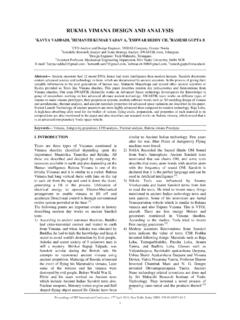Transcription of ETAP Model For Earth Mat Design ETAP MODEL ... - …
1 ETAP MODEL For Earth Mat Design Proceedings of International Academic Conference on Electrical, Electronics and Computer Engineering, 8th Sept. 2013, Chennai, India ISBN: 978-93-82702-28-3 84 ETAP MODEL FOR Earth MAT Design 1 PREMALATHA POTTA, 2R BALAKRISHNAN 1,2 Electrical, Larsen & Toubro Limited, Construction, Chennai, India Abstract with the incessant increase of power system capacity and voltage grade, the safety of grounding grid becomes more and more prominent. In substation, earthing system is essential not only to provide the protection to people working or walking in the vicinity of earthed facilities and equipment s against the danger of electrical shock, but also to maintain the proper function of the electrical system. This paper presents the Design of earthing systems for 66KV substation and the case study for calculating required parameters and reviews substation grounding practices with special reference to safety and development criteria for a safe Design .
2 In this paper, a real time case study has been considered and the Design was done using ETAP (Electrical Transient Analyzer Program) software. Simulation of power system analysis using computer software s enables better understanding of the large system and provides better solution to problem. Keywords: Earthing / Grounding, Ground Resistance, Step Potential, Touch Potential, Ground Potential Rise, Earth mat, Electrodes, Software and Simulation. I. INTRODUCTION Electricity today is playing an ever increasing role in the lives of everyone in the civilized world. Increased use of electricity has resulted in increased danger to human beings. Not only defects at consumer's premises, but even at Supply Authority's premises can electrocute a customer at his own premises.
3 Earthing protects humans from danger of electrocution. A lightening strike on a tall building can seriously injure the occupants or even completely demolish that building. Tall buildings or structures like towers are more prone to lightening strikes. Earthing tall structures protects them against lightening. Earthing provides return path for large number of electronic equipments or RF antennas etc. For example, a 3phase star wound generator must have its neutral point at Earth potential. Earthing a tower / equipment means connecting that tower /equipment to general mass of Earth by means of an electrical conductor. Connection to Earth is achieved by embedding a metal plate or rod or conductor in Earth . This metal plate or rod or conductor is called as " Earth electrode".
4 Effectiveness of the Earthing connection made by embedding a metal plate in Earth is quantified as " Earth Resistance". This Earth resistance is measured in ohms. In general earthing installations will be required at power stations and substations for: a) The neutral points of each separate electricity system which has to be earthed at the power station or substation b) Apparatus framework or cladding or other non-current carrying metalwork associated with each system, for example, transformer tanks, power cable sheaths; c) Extraneous metalwork not associated with the power systems, for example boundary fences, sheaths of control or Communication cables. The function of an Earthing and bonding system is to provide an Earthing system connection to which transformer neutrals or Earthing impedances may be connected in order to pass the maximum fault current.
5 The Earthing system also ensures that no thermal or mechanical damage occurs on the equipment within the substation, thereby, resulting in safety to operation and maintenance personnel. The Earthing system also guarantees eq uipotential bonding, such that there are no dangerous potential gradients developed in the substation. In designing the substation, three voltages have to be considered. Touch voltage: This is the difference in potential between the surface potential and the potential at earthed equipment whilst a man is standing and touching the earthed surface Step Voltage: This is the potential difference developed when a man bridges a distance of 1 m with his feet while not touching any other earthed equipment Mesh Voltage: This is maximum touch voltage that is developed in the mesh of earthing grid.
6 This paper briefly discusses about the Earth mat Design and procedure for the same. It covers some of the practical aspects of Earthing in detail. The goal of this paper is to Design Earth mat / Earth grid, conductor size, vertical electrode size, permissible potential difference, grid resistance, maximum grid current, ground potential rise by a computer modeling. Here, the Design uses ETAP (Electrical Transient Analyzer Program) software. ETAP is the most comprehensive enterprise solution for Design , simulation, operation, control, optimization, and automation of generation, transmission, distribution and industrial power systems. II. CONVENTIONAL EARTHING & EATH MAT Design A. Conventional Earthing The conventional system of Earthing calls for digging of a large pit into which a GI pipe or a copper plate is positioned amidst layers of charcoal and salt.
7 It is cumbersome to install only one or two pits in a day. Types of conventional Earthing are shown below: a. Pipe Earthing ETAP MODEL For Earth Mat Design Proceedings of International Academic Conference on Electrical, Electronics and Computer Engineering, 8th Sept. 2013, Chennai, India ISBN: 978-93-82702-28-3 85 b. GI Pipe Earthing c. Cast Iron Plate Earthing d. Copper Plate Earthing The conventional system of GI pipe Earthing or copper plate Earthing requires maintenance and pouring of water at regular interval. B. Earth mat Design Substation Earth system will have a combination of buried horizontal conductors in rows and columns and vertical electrodes. A sold metallic plate or a system of closely spaced bare conductors that are connected to and often placed in shallow depths above a ground grid or elsewhere at the Earth s surface, in order to obtain an extra protective measure minimizing the danger of the exposure to high step or touch voltages in a critical operating area or places that are frequently used by people.
8 Grounded metal gratings placed on or above the soil surface, or wire mesh placed directly under the surface material, are common form of a ground mat. Advantageous of Earth mat: 1. Earth mat is preferable for large substations 2. To minimize the danger of high step or touch voltages in critical operating area or places that are frequently used by people 3. Space saving on the ground level due to substantial reduction of Earth pits which leads to easy of coordination III. EARTHING SYSTEM FOR SUBSTAION An effective substation Earthing system typically consists of Earth rods, connecting cables from the buried earthing grid to metallic parts of structures and equipment, connections to earthed system neutral and the Earth surface insulating covering material. Current flowing into the Earthing grid from lightning arrester operation, impulse or switching surge flashover of insulators and line to ground fault current from the bus or connected transmission lines all cause potential differences between earthed points in the substation.
9 Without a properly designed Earthing system, large potential differences can exist between different points with the substation itself. Under normal circumstances, it is the current constitutes the main threat to personal An effective earthing system has the following objectives: a. Ensure such a degree of human safety that a person working or walking in the vicinity of earthed facilities is not expressed to the danger of a critical electric shock. The touch and step voltage produced in a fault condition have to be at safe values. A safe value is one woll not produce enough current within a body to cause ventricular fibrillation b. Provide means to carry and dissipate electric currents into Earth under operation and equipment limits or adversely affecting continuity of services c.
10 Provide earthing for lightning impulses and the surges occuring from the switching of substation equipment, which reduces damage to equipment and cables d. Provide a low resistance for the protective relays to see and clear ground faults, which improves protective equipment performance, particularly at minimum fault IV. DESIGNOF GROUNDING SYSTEMS FOR LIMITED AREA HIGH RESISTIVITY STATIONS The Design of grounding system for rocky areas requires special measures to obtain safe step and touch potentials for grounding system. Some of the measures to reduce the grounding A. Use of vertical Grounding Rods A grounding system at a power station often requires the form of a horizontal grid supplemented by number of vertical rods. The ground rods are of particular value when the upper layer of soil in which grid is buried is of much higher resistivity than that of the soil beneath.





